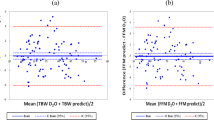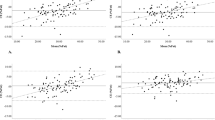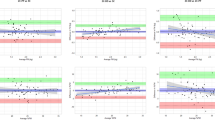Abstract
PURPOSE: The purpose of the study was to compare estimates of body density and percentage body fat from air displacement plethysmography (ADP) to those from hydrodensitometry (HD) in adults and children and to provide a review of similar recent studies.
METHODS: Body density and percentage body fat (% BF) were assessed by ADP and HD on the same day in 87 adults aged 18–69 y (41 males and 46 females) and 39 children aged 8–17 y (19 males and 20 females). Differences between measured and predicted thoracic gas volumes determined during the ADP procedure and the resultant effects of those differences on body composition estimates were also compared. In a subset of 50 individuals (31 adults and 19 children), reliability of ADP was measured and the relative ease or difficulty of ADP and HD were probed with a questionnaire.
RESULTS: The coefficient of reliability between %BF on day 1 and day 2 was 96.4 in adults and 90.1 in children, and the technical error of measurement of 1.6% in adults and 1.8% in children. Using a predicted rather than a measured thoracic gas volume did not significantly affect percentage body fat estimates in adults, but resulted in overestimates of percentage body fat in children. Mean percentage body fat from ADP was higher than percentage body fat from HD, although this was statistically significant only in adults (29.3 vs 27.7%, P<0.05). The 95% confidence interval of the between-method differences for all subjects was −7 to +9% body fat, and the root mean square error (r.m.s.e.) was approximately 4% body fat. In the subset of individuals who were asked to compare the two methods, 46 out of 50 (92%) indicated that they preferred the ADP to HD.
CONCLUSION: ADP is a reliable method of measuring body composition that subjects found preferable to underwater weighing. However, as shown here and in most other studies, there are differences in percentage body fat estimates assessed by the two methods, perhaps related to body size, age or other factors, that are sufficient to preclude ADP from being used interchangeably with underwater weighing on an individual basis.
This is a preview of subscription content, access via your institution
Access options
Subscribe to this journal
Receive 12 print issues and online access
$259.00 per year
only $21.58 per issue
Buy this article
- Purchase on Springer Link
- Instant access to full article PDF
Prices may be subject to local taxes which are calculated during checkout

Similar content being viewed by others
References
Fomon S, Jesson R, Owen GM . Determination of body volume from infants by a method of helium displacement Ann N Y Acad Sci 1963 110: 80–90.
Gnaedinger R, Reinike E, Pearson A, Van Huss W, Wessel J, Montoye H . Determination of body density by air displacement, helium dilution, and underwater weighing Ann NY Acad Sci 1963 110: 96–108.
Taylor A, Aksoy Y, Scopes J, Du Mont G, Taylor B . Development of an air displacement method for whole body volume measurement in infants J Biomed Eng 1985 7: 9–17.
Dempster P, Aitkens S . A new air displacement method for the determination of body composition Med Sci Sports Exerc 1995 27: 1692–1697.
McCrory MA, Gomez TD, Bernauer EM, Mole PA . Evaluation of a new air displacement plethysmograph for measuring human body composition Med Sci Sports Exerc 1995 27: 1686–1691.
Biaggi RJ, Vollman MW, Nies MA, Brener CE, Flakoll PJ, Levenhagen DK, Sun M, Karabulut Z, Chen KY . Comparison of air-displacement plethysmography with hydrostatic weighing and bioelectrical impedance analysis for the assessment of body composition in healthy adults Am J Clin Nutr 1999 69: 898–903.
Collins MA, Millard-Stafford ML, Sparling PB, Snow TK, Rosskopf LB, Webb SA, Omer J . Evaluation of the Bod Pod for assessing body fat in collegiate football players Med Sci Sports Exerc 1999 31: 1350–1356.
Iwaoka H, Yokoyama T, Nakayama T, Matsumura Y, Yoshitake Y, Fuchi T, Yoshiike N, Tanaka H . Determination of percent body fat by the newly developed sulfur hexafluoride dilution method and air displacement plethysmography J Nutr Sci Vitaminol 1998 44: 561–568.
Sardinha LB, Lohman TG, Teixeira PJ, Guedes DP, Going SB . Comparison of air displacement plethysmography with dual-energy X-ray absorptiometry and 3 field methods for estimating body composition in middle-aged men Am J Clin Nutr 1998 68: 786–793.
Dewit O, Fuller N, Elia M, Wells J . Whole-body plethysmography compared with hydrodensitometry for body composition analysis Proc Nutr Soc 1998 58: 59A.
Nuñez C, Kovera AJ, Pietrobelli A, Heshka S, Horlick M, Kehayias J, Wang Z, Heymsfield SB . Body composition in children and adults by air displacement plethysmography Eur J Clin Nutr 1999 53: 382–387.
Roche AF . Growth, maturation and body composition: The Fels Longitudinal Study 1929–1991 Cambridge University Press: Cambridge 1992.
Dubois D, Dubois EF . A formula to estimate the approximate surface area if height and weight be known Arch Intern Med 1916 17: 863–871.
Crapo RO, Morris AH, Clayton PD, Nixon CR . Lung volumes in healthy non-smoking adults Bull Eur Physiopath Respir 1982 18: 419–425.
Siri, WE . The gross composition of the body. In: C Tobias, J Lawrence (eds). Advances in biological and medical physics. Academic Press: New York 1956 239–280.
Levenhagen D, Borel MJ, Welch D, Piasecki J, Piasecki D, Chen K, Flakoll P . A comparison of air displacement plethysmography with three other techniques to determine body fat in healthy adults J Parentera Enteral Nutr 1999 23: 293–299.
Elia M, Ward LC . New techniques in nutritional assessment: body composition methods Proc Nutr Soc 1999 58: 33–38.
Roche A . Anthropometry and ultrasound. In: A Roche, S Heymsfield, T Lohman (eds). Human body composition. Human Kinetics: Champaign, IL 1996 167–189.
Going S . Densitometry. In: A Roche, S Heymsfield, T Lohman (eds). Human body composition. Human Kinetics: Champaign, IL 1996 pp 3–24.
McCrory MA, Mole PA, Gomez TD, Dewey KG, Bernauer EM . Body composition by air-displacement plethysmography by using predicted and measured thoracic gas volumes J Appl Physiol 1998 84: 1475–1479.
Acknowledgements
We gratefully acknowledge Alesha Patterson, Derrick Coleman, Merita Moffitt and Jean Payne for their technical assistance with this study. Funding was provided through a Research Challenge Grant from Wright State University, NIH HD12252 and NIH HD27063.
Author information
Authors and Affiliations
Corresponding author
Rights and permissions
About this article
Cite this article
Demerath, E., Guo, S., Chumlea, W. et al. Comparison of percent body fat estimates using air displacement plethysmography and hydrodensitometry in adults and children. Int J Obes 26, 389–397 (2002). https://doi.org/10.1038/sj.ijo.0801898
Received:
Revised:
Accepted:
Published:
Issue Date:
DOI: https://doi.org/10.1038/sj.ijo.0801898
Keywords
This article is cited by
-
Effect of total body water estimates via bioimpedance on bod pod-based three-compartment body fat models
European Journal of Clinical Nutrition (2022)
-
Fat-free mass prediction equations for bioelectric impedance analysis compared to dual energy X-ray absorptiometry in obese adolescents: a validation study
BMC Pediatrics (2015)
-
Oxygen uptake kinetics in trained adolescent females
European Journal of Applied Physiology (2015)
-
Methodologies to assess paediatric adiposity
Irish Journal of Medical Science (1971 -) (2015)
-
Measurement of longitudinal changes in body composition during weight loss and maintenance in overweight and obese subjects using air-displacement plethysmography in comparison with the deuterium dilution technique
International Journal of Obesity (2011)



